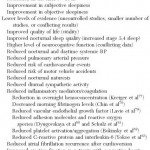 Multiple effects of PAP treatment have been documented (Table 1). One can classify possible benefits from PAP treatment into four categories: (1) improvement of symptoms such as daytime sleepiness, disturbed sleep, impaired quality of life, or cognition; (2) reduced bed partner sleep disturbance or quality of life; (3) reduction of risk for cardiovascular disease, neurocognitive degeneration, or increased mortality associated with sleep apnea; and (4) reduction in the risk for motor vehicle accidents. As noted above, controlled trials (pill or sham CPAP) have shown improvements in subjective and objective sleepiness after PAP treatment. For example, Jenkinson et al using subtherapeutic CPAP as a control demonstrated a decrease in the ESS score and an increase in sleep latency (Osler wakefulness test).
Multiple effects of PAP treatment have been documented (Table 1). One can classify possible benefits from PAP treatment into four categories: (1) improvement of symptoms such as daytime sleepiness, disturbed sleep, impaired quality of life, or cognition; (2) reduced bed partner sleep disturbance or quality of life; (3) reduction of risk for cardiovascular disease, neurocognitive degeneration, or increased mortality associated with sleep apnea; and (4) reduction in the risk for motor vehicle accidents. As noted above, controlled trials (pill or sham CPAP) have shown improvements in subjective and objective sleepiness after PAP treatment. For example, Jenkinson et al using subtherapeutic CPAP as a control demonstrated a decrease in the ESS score and an increase in sleep latency (Osler wakefulness test).
The effect of PAP treatment on quality of life measures has been studied using the Short Form Health Survey (SF-36) and functional outcomes of sleep questionnaire (FOSQ). The SF-36 has been used for many types of health problems, while the FOSQ evaluates the impact of sleepiness on the ability to perform activities of daily living. Some studies showed that PAP treatment improves some SF-36 measures (vitality, energy)’ and FOSQ productivity and energy measures. In contrast, Barbe et al, using a randomized control trial of 6 weeks of CPAP vs sham CPAP treatment in severe OSA (AHI > 30/h) without daytime sleepiness, found no improvement in quality of life measures (FOSQ, SF-36) or cognitive function.
In some severely sleepy OSA patients, there may be a higher-than-normal amount of stage 3,4 and/or stage REM sleep (rebound) on the initial night of CPAP titration. In less sleepy patients, this may not occur possibly due to difficulties adapting to monitoring equipment or the first exposure to PAP. In a randomized controlled trial (placebo capsules vs CPAP), McArdle and Douglas demonstrated an increase in stage 3,4 sleep and a decrease in stage 1 sleep and arousals after 1 month of CPAP treatment; in this study, the amount of REM sleep did not increase. Another study demonstrated a significant decrease in total arousal index with CPAP compared to sham CPAP (2 cm H2O) after 7 days of treatment, Studies of the effects of PAP on neurophysio-logic function have been inconsistent in their findings. There are a number of challenges in performing these studies, including controlling for the effect of learning on repeated testing and the difficulties of completing studies with longer periods of treatment. Bardwell and coworkers compared 1 week of CPAP vs sham CPAP on changes in 21 neuropsychological tests and found a benefit only when analyzing the entire group of tests. No individual test showed significant results. Henke et al found that CPAP improved a number of neuropsychological measures but that there was no difference in benefit between effective and ineffective CPAP.
Most physicians treating OSA patients are well aware of the impact of disease and treatment on their patient’s bed partner. One study found CPAP treatment increased the sleep time of bed partners of patients with OSA by almost an additional hour. Another study found that CPAP treatment improved quality of life measures in the bed partners of patients with sleep apnea.
The third group of PAP benefits includes a possible decrease in mortality from adverse cardiovascular events or other long-term benefits of PAP treatment. Long-term randomized controlled trials of CPAP treatment in patients with OSA are difficult to perform and for severely affected patients might raise ethical issues. Several observational studies have found a benefit of CPAP treatment in mortality or development of cardiovascular disease. He and coworkers in a retrospective analysis found an increased mortality in untreated OSA patients with an apnea index > 20 compared to those treated with CPAP. However, no information on the cause of death was provided. Peker et al observed a group of patients with OSA for 7 years and found a sixfold increased incidence of cardiovascular disease in incompletely treated patients compared to those adequately treated with CPAP. A large observational study by Marin and coworkers (mean follow-up of 10 years) found about a threefold increase in fatal and nonfatal cardiovascular events in untreated OSA patients, compared to either healthy men or OSA patients treated with CPAP. Another study prospectively followed up a large group of patients over at least 5 years and compared those intolerant to CPAP with those receiving CPAP. Total cardiovascular events were more common in the untreated group (31% vs 18%). The above evidence, although imperfect, suggests PAP treatment reduces the longterm adverse effects of untreated moderate-to-se-vere OSA. This provides the rationale for the recommendation of PAP treatment for such patients regardless of whether symptoms are present.
Table 1—Effects of PAP Treatment

Category: Apnea
Tags: autoadjusting positive airway pressure, continuous positive airway pressure adherence, obstructive sleep apnea, positive airway pressure treatment